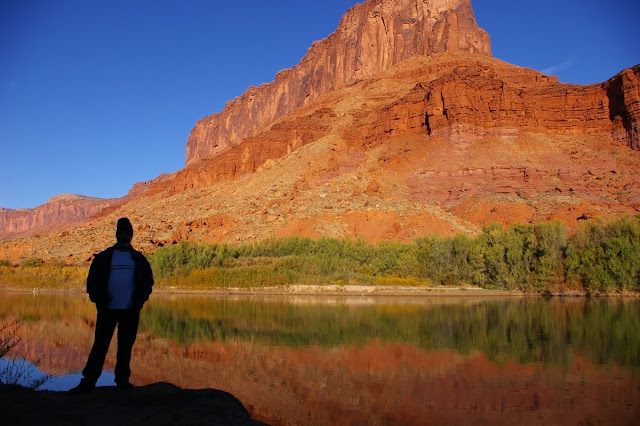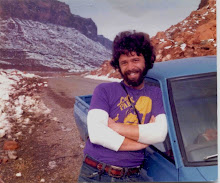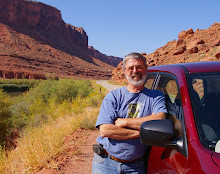My first day on the job in Canyonlands,
I was confronted by Harry Yount, first-ever park ranger and mountain man of
Yellowstone, whose leathery countenance stared out at me from a faded
photograph in the dilapidated trailer we called an office in the Needles
District – the very same trailer, I was told, in which Ed Abbey wrote Desert
Solitaire when he was a seasonal ranger at the Arches. Over the next few weeks, I’d hear this
particular rumor applied to several other weathered metal hulks scattered
throughout the canyon country,
My first assignment in the Needles:
Learn how to drive a jeep, and head up to Davis Canyon to repair a vandalized
cliff dwelling. I was introduced to Ken,
a fellow ranger and native of Moab, Utah.
Within minutes of our meeting, we were in a lime-green government rig,
moving quickly under a cool gray sky.
About five miles from headquarters we took
the turnoff to Davis Canyon, leaving the paved road and the broad valley of
Indian Creek for the avenue of cliffs beyond.
I absorbed as much of the scenery as possible while Ken drove the first
part of the canyon, offering tips on vehicle control and pointing out
ruins. I settled into the bouncing
rhythm of the jeep and began training my eyes to see the subtle signs of prehistoric
habitation – little square windows against a cliff, methodical layers of
sandstone masonry.
Shortly past noon we reached our
destination, a narrow drainage filled with Indian ruins on both sides. The one we were looking for was perched on a
ledge under a pothole arch and we’d have to climb down to it from above
The air grew chill and dark, biting
against our faces as we climbed the rounded cliffs of sandstone. We were soon on top, moving carefully across
ledges, carrying rope and climbing gear over our shoulders, stopping finally at
a large horizontal hole in the cliff twenty feet across and shaped like an
immense toilet seat.
We walked around the far side of the
hole until we could see below us a narrow ledge about fifteen feet away. Perched upon it was a small square structure
of earth and stone. A nearby juniper
provided a belay point for our ropes as we tied them off and rappelled down to
the ledge. The ruin was about five feet
thigh, its ceiling built squarely against a curving wall of the arch. A wooden floor divided it in half, and there
was a small opening in each level. I
marveled at the workmanship, at the ancient fingerprints still visible in the
dry mortar. It was a two-story granary
of some kind.
A small dried up corn cob lay nearby,
its shape barely altered by time. While
it looked like it might have been discarded only recently, we knew we were
looking at an agricultural product from 700 years before, preserved intact by
the dry climate. We began looking for signs of vandalism. The granary was in excellent shape, probably
visited by only a handful of people a year.
But around its backside, nearly hidden in the shadow of a nearby wall,
someone had carved their message in the ancient clay, in letters almost an inch
high:
HA-HA. WE WERE HERE BEFORE YOU.
As the sky darkened through the oval
opening above us, I could almost feel the presence of Anasazi spirits
condemning the modern intruders. I turned to Ken and suggested we wet some of
the fine red dirt, make a paste out of it, and plaster it over the
letters. We mixed our saliva with the
dust, making clay in our palms and applying it to the graffiti. The letters disappeared as the clay blended
in, and the wall’s original appearance was restored. As we paused to admire our work, we hear the
sound of rain up above.
“Jeez, we’d better get out of here fast
before the rock gets too slick! Do you
know how to use jumars?” Ken asked.
“It’s been a while, but I think so.”
Actually, I sucked at using jumars but I didn’t want to admit it.
We quickly attached the jumar handles
to the dangling rope, their looped ends going around my boots. I began my ascent, slowly lifting each handle
and each leg in unison as the rain increased in intensity. It was slow going as the rope became damp and
slippery. I was nearly halfway to the
top when I saw a small trickle of water spilling over the same notch where the
rope hung. Soon it was splashing my face
and running over my hands. Despite
mounting anxiety, I managed to reach the top.
I immediately dropped the jumars down to Ken. By this time, a small stream was flowing over
the lip of the arch, pouring right onto Ken who was struggling with the
equipment, trying to slide each jumar up the saturated rope.
When he neared the top, I grabbed the
rope and pulled with all my strength until Ken made it over the lip and onto
relatively level ground. We swiftly
gathered our gear and headed over the rocks toward the jeep, the rain now a
relentless torrent, unleashing waterfalls and sudden streamlets from every
direction, as if someone had turned on hundreds of faucets all at once. Slipping several times as we ran, ropes
dangling, packs bouncing, we soon saw the jeep just a few hundred yards
away. By this time my near-panic had
turned from our slippery climb to the flash flood that might come sweeping down
the canyon at any minute if the rain continued.
But almost as soon as we reached the
jeep the torrent ceased, the roar of the water rapidly diminishing until only a
few small waterfalls could be heard. The
air regained its dry demeanor and the aroma of damp sage filled the
canyon. A few squawking ravens flew by,
their cries echoing off of moist sandstone.
I took my place behind the wheel and began driving the sandy road out of
Davis Canyon, commenting to Ken as we rumbled
homeward, “If every day here is as exciting as this one, I may not survive this
job!”
I was half-joking, soaked and
exhilarated, and breathless in a new realm.




